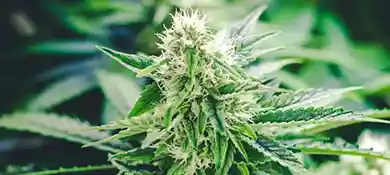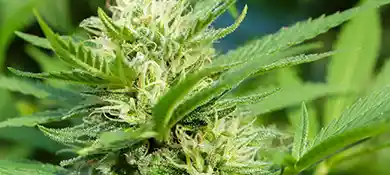Optimizing Plant Growth with Greenhouse Evaporative Cooler
Greenhouses offer a controlled environment for plants, where temperature and humidity become key variables in their growth cycle. The greenhouse evaporative cooler is a reliable tool in this setting, facilitating optimal growth conditions. This guide provides a thorough overview of the principle and operational facets of greenhouse evaporative cooler.
Subsequent sections will delineate the various types available, each tailored to specific greenhouse parameters. Despite their evident advantages, these coolers present certain challenges that warrant thorough consideration. Discussions encompassing water quality, energy expenditure, and requisite maintenance will be presented to provide a holistic understanding.
An overview of leading market brands will also be provided to assist in informed decision-making. The ultimate objective of this blog is to elucidate the intricacies of greenhouse evaporative cooling, ensuring readers are aptly equipped to optimize their greenhouse environments.
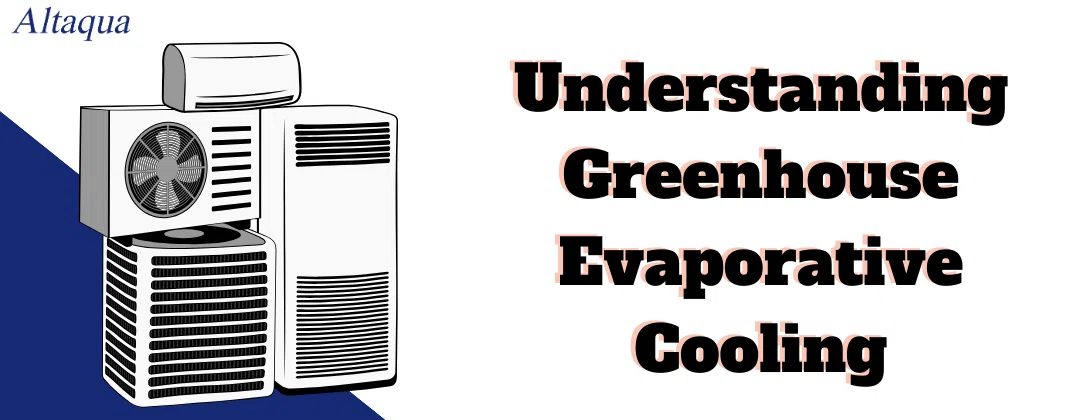
Understanding Greenhouse Evaporative Cooling
Within a greenhouse, managing the internal temperature is paramount for ensuring the health and productivity of plants. As the sun's intensity varies, maintaining a consistent climate becomes challenging. The greenhouse evaporative cooler serves as a solution, ensuring an optimal environment for plant growth.
What is Evaporative Cooling?
Evaporative cooling is rooted in thermodynamics. The process of a liquid converting into vapor invariably leads to a reduction in temperature. As water molecules harness energy from their surroundings, they evolve from their liquid form into a gaseous one. This shift is energy-intensive, primarily drawing heat from the surrounding air, which cools it. This cooling dynamic is especially evident in regions with diminished humidity. The underlying factor is that drier atmospheres have the capacity to hold more water vapor, which in turn amplifies the cooling sensation.
The Importance of Cooling in Greenhouses
The dynamics within a greenhouse are intricate. While the structure's primary purpose is to harness sunlight and warmth, there's a fine balance to strike. Too much heat can be detrimental. Elevated temperatures can reduce photosynthetic efficiency, transpiration stress, and plant cellular damage. Plants also tend to respire more at higher temperatures, which can lead to faster consumption of stored energy, reducing overall growth and yield. In this light, efficient cooling doesn't merely enhance growth but is vital for preventing potential plant damage.
What is a Greenhouse Evaporative Cooler?
Distinct from traditional cooling systems, a greenhouse evaporative cooler is tailored for the unique environment of greenhouses. It capitalizes on the principle of evaporative cooling to moderate temperatures. Rather than just circulating air, it adds moisture to the air, and as this moisture evaporates, it draws heat from the environment, cooling it in the process.
How Do Greenhouse Evaporative Coolers Work?
The synergy between water and air movement is at the heart of a greenhouse evaporative cooler. The system usually consists of a water reservoir, distribution mechanisms, and fans. Water is channeled to a porous medium, often cooling pads. As fans draw external air into the greenhouse, this air is forced through the wet pads. The immediate contact with the wet medium causes the water to evaporate, drawing heat from the incoming air. The result is a cooler, moisture-rich breeze dispersed throughout the greenhouse. The balance between air intake and exhaust ensures the humidity doesn't reach levels detrimental to plant health. Moreover, the system's continual operation guarantees that the greenhouse environment remains consistent, mitigating temperature fluctuations detrimental to plant growth.
Greenhouse Evaporative Cooling is an essential mechanism that balances the greenhouse's internal temperature, optimizing plant health and productivity. These coolers provide an energy-efficient, consistent environment that maximizes plant growth while safeguarding them from potential heat-induced damage.
Types of Evaporative Coolers for Greenhouses
Now that we have a foundational grasp of greenhouse evaporative cooling, the next step is understanding the specific tools and mechanisms by which this cooling is achieved. The effectiveness of greenhouse cooling often hinges on the type of system implemented. Therefore, familiarity with the nuances of each system type not only aids in making an informed choice but also ensures optimal greenhouse conditions.
Pad and Fan System
The Pad and Fan System relies on two primary components: water-saturated pads and powerful fans. These pads are kept moist through a water reservoir and pump system. As the fans draw in air, it passes through the wet pads. The pad water evaporates, pulling heat from the air in the process. The outcome is a significant drop in temperature as the cooler, humidified air is circulated throughout the greenhouse. This direct evaporative cooling method is efficient and best suited for larger areas that require uniform cooling.
Misting System
The Misting System uses a fine mist of water in the greenhouse environment. High-pressure pumps push water through specially designed nozzles, creating a mist that rapidly evaporates. Like other evaporative cooling methods, water turning to vapor absorbs heat, cooling the surrounding air. While effective, monitoring humidity levels is crucial, ensuring they don't reach detrimental levels for plants.
Wet Wall System
This system extends the Pad and Fan method but is integrated into an entire greenhouse wall. Water is circulated down the wall, and as air is drawn through this wall by fans on the opposite side, it captures moisture, leading to cooling. Given its expansive coverage, the Wet Wall System is highly effective in regulating temperatures in larger greenhouses.
Chilled Water Circulation System
In this system, water is cooled in an external chiller before circulating through a network of pipes in the greenhouse. As the cooled water travels through these pipes, fans blow air over them, reducing the air temperature. Given its mechanism, it provides consistent temperatures and is ideal for larger greenhouses where uniformity is essential.
Exhaust Fan System
The principle behind the Exhaust Fan System is simple but effective. Warm air rises, and this warm air is extracted by placing exhaust fans at the top or side of the greenhouse. As it's removed, cooler external air is drawn in, helping maintain a more consistent temperature. This method is particularly beneficial in climates with a substantial evening temperature drop.
Understanding the intricate workings of each system aids in determining the best evaporative cooler for specific greenhouse needs, ensuring plant vitality and cost-effectiveness.
Pros and Cons of a Greenhouse Evaporative Cooler
Having delved into the intricacies of greenhouse evaporative cooling and its operational aspects, assessing this technology from a holistic perspective is equally imperative. While the merits are evident and profound, weighing them against the potential limitations is only fair and prudent. As we transition into the pros and cons of the greenhouse evaporative cooler, we aim to present a balanced overview, enabling informed decision-making for those contemplating its adoption.
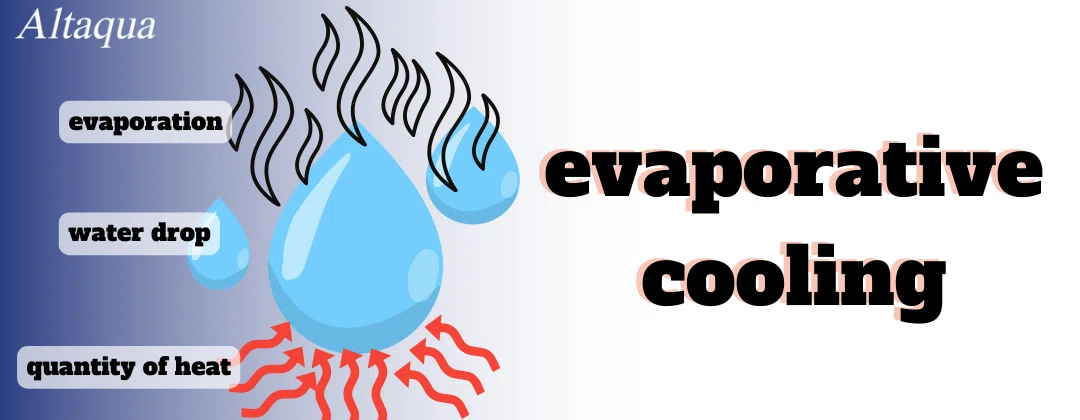
Pros of a Greenhouse Evaporative Cooler
The merits of using a greenhouse evaporative cooler aren't merely confined to its fundamental cooling action. It encompasses a broader spectrum of benefits, ensuring the optimal temperature and fostering an environment conducive to robust plant growth.
Temperature Reduction
Evaporative coolers are engineered to leverage the natural water evaporation process for cooling purposes. In simple terms, when water evaporates, it consumes heat from its surroundings, leading to a drop in temperature. Inside a greenhouse, as the cooler disperses water into the environment, it evaporates by pulling the necessary heat from the ambient air. This results in cooler air, providing a conducive environment for plants. The greenhouse evaporative cooler ensures an even and consistent spread of moisture, facilitating continuous and efficient cooling even during periods of intense heat. This principle is the foundation of its effectiveness in regulating temperature.
Energy Efficiency and Environmental Friendliness
Traditional cooling mechanisms often rely on chemical refrigerants and extensive electrical input. In contrast, greenhouse evaporative coolers harness the natural property of water to absorb heat during evaporation. This process demands minimal electrical energy for water distribution and fan operation. The absence of harmful refrigerants and reduced electrical consumption make it a more sustainable and environmentally conscious choice.
Low Maintenance Costs
The structural simplicity of greenhouse evaporative coolers is a strength. With fewer moving parts than conventional coolers and the absence of intricate electronic components, the likelihood of technical glitches is reduced. This translates to fewer repair needs and longer intervals between maintenance checks, ensuring operational costs remain manageable over time.
Improved Plant Growth
Temperature directly influences plant metabolic activities. Excessive heat can deter photosynthesis, the critical process through which plants convert light into energy. By facilitating consistent temperature levels, the evaporative cooler ensures that photosynthetic efficiency remains optimal. Moreover, the cooler's ability to prevent abrupt temperature spikes prevents potential cellular damage in plants, safeguarding their health and ensuring robust growth.
Humidity Control
While the primary goal of the evaporative cooler is temperature regulation, its operation also has a secondary benefit: humidity control. In the evaporation process, moisture is introduced into the air. For plants, especially those native to tropical or moisture-rich environments, this added humidity can be pivotal. It aids in preventing leaf dehydration and ensures stomatal activities, crucial for nutrient uptake, proceed without hindrance. The design of the greenhouse evaporative cooler ensures that while humidity is introduced, it doesn't reach excessive levels that might promote fungal growth, striking a balance crucial for plant health.
Cons of a Greenhouse Evaporative Cooler
The greenhouse evaporative cooler, like any technology, is not without its challenges. While its benefits in promoting plant growth and maintaining optimal greenhouse conditions are clear, certain constraints should also be noted. These limitations are not insurmountable but demand awareness and planning for efficient use.
Dependence on Climate Conditions
The core working principle of a greenhouse evaporative cooler revolves around the evaporation of water to cool the surrounding air. In regions with low humidity, the air has a higher capacity to hold additional moisture, making the cooling process more effective. However, in high humidity conditions, the air is already saturated with moisture, limiting the amount of water that can be evaporated. This saturation reduces the cooling capacity of the system. Therefore, the greenhouse evaporative cooler might not be the most efficient cooling option in consistently high-humidity areas.
Water Consumption
The greenhouse evaporative cooler operates by evaporating water to achieve cooling. Consequently, it requires a substantial amount of water to function efficiently. In areas prone to water scarcity or where water resources are limited, this could be a significant drawback. In the context of increasing global water scarcity, evaluating the long-term feasibility of using such systems is essential.
Maintenance Requirements
The very nature of the evaporative cooling process means the system is exposed to a constant water flow. This can lead to mineral buildup on cooling pads, potential waterborne microbial growth, and sediment accumulation in the reservoir. These factors can decrease the system's efficiency if not regularly cleaned and maintained. Blocked or inefficient water distribution can also lead to uneven cooling. Hence, while the system might have low maintenance costs, the required maintenance frequency is relatively high.
Limited Temperature Control
Greenhouse evaporative coolers are adept at reducing temperatures, but their ability to modulate temperature within very specific and narrow ranges is limited. The cooling achieved is directly proportional to the ambient humidity levels. On extremely hot days with high humidity, the system might struggle to lower the temperature to the desired level. This limitation can be challenging for plants that thrive within specific temperature parameters, especially during unpredictable weather patterns.
In summary, greenhouse evaporative coolers present both advantages and challenges. They excel in temperature control, energy efficiency, and plant growth enhancement while maintaining low costs. Yet, they're climate-dependent, consume significant water, and have specific maintenance demands. It's essential to balance these factors when considering their application in different greenhouse environments.
Top Greenhouse Evaporative Cooler Brands
Having navigated the various advantages and challenges associated with greenhouse evaporative coolers, it's only logical to delve into the brands that stand out in this sector.
EssickAir
Known for its precision engineering, EssickAir is an American gem in evaporative coolers. Their products encapsulate the perfect blend of craftsmanship and innovation. With their high-performance coolers, they've perfected a unique balance between efficient cooling and sustainable design. Their easy-to-install systems, accentuated by their bolted construction, ensure longevity. Moreover, the brand's focus on quiet operation and durability, even in the driest climates, distinguishes it from a market of competitors.
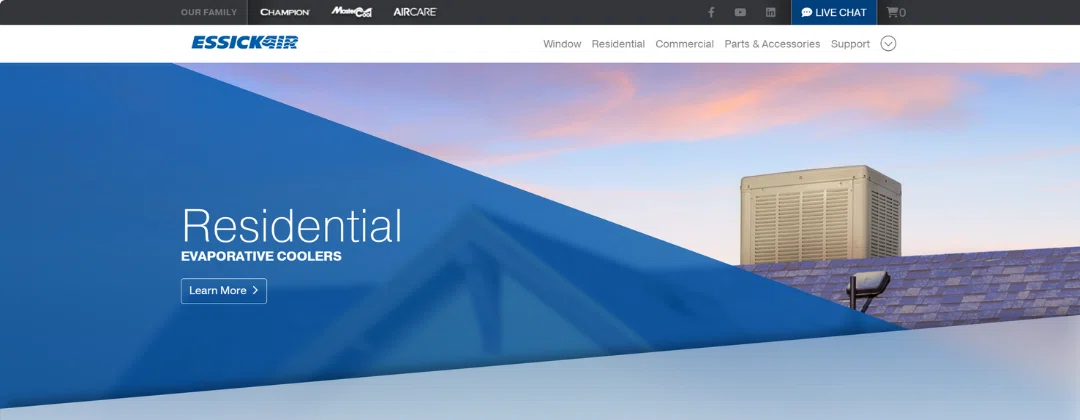
Schaefer
Schaefer’s WayCool® series embodies the future of eco-friendly cooling. Their portable coolers harness the natural cooling ability of water evaporation, making them an ideal choice for indoor and outdoor settings. While most coolers offer coverage, Schaefer promises focused, high-velocity air streams even in vast areas. A standout feature is their energy efficiency, making cooling large spaces economically viable. The brand has seamlessly integrated sustainability with technology, ensuring long-lasting evaporative pads and automatic shut-offs, which enhance the product’s lifespan.
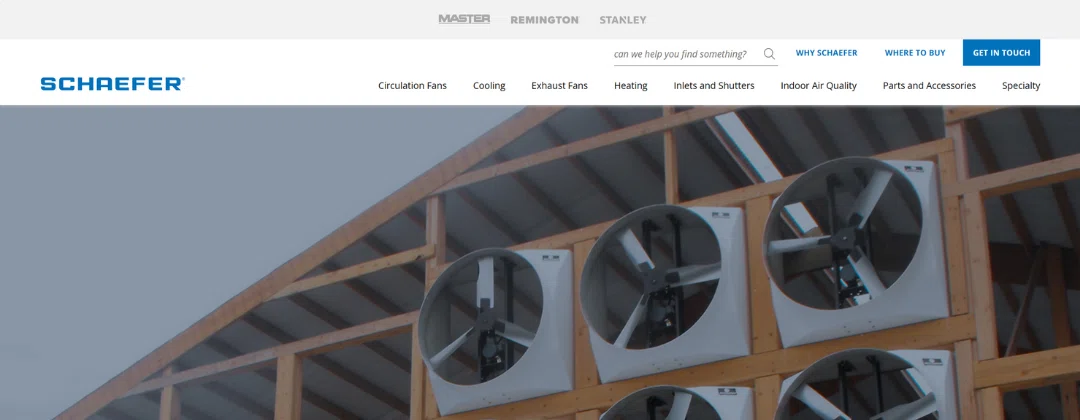
Hessaire
Hessaire offers a range of evaporative coolers known for their compact design without compromising cooling efficiency. One of their notable advancements is the use of high-density XeL50 rigid media, which allows for an impressive 80% more evaporation surface compared to other coolers in its class. This results in enhanced evaporation efficiency and cooler temperatures. They also focus on design functionality; the three-panel air intake system is an innovative feature that maximizes air delivery, while the ABS resin construction ensures a lightweight yet sturdy build. Notably, Hessaire emphasizes the importance of energy conservation, positioning their coolers as more efficient alternatives to traditional air conditioners, especially in dry climates.
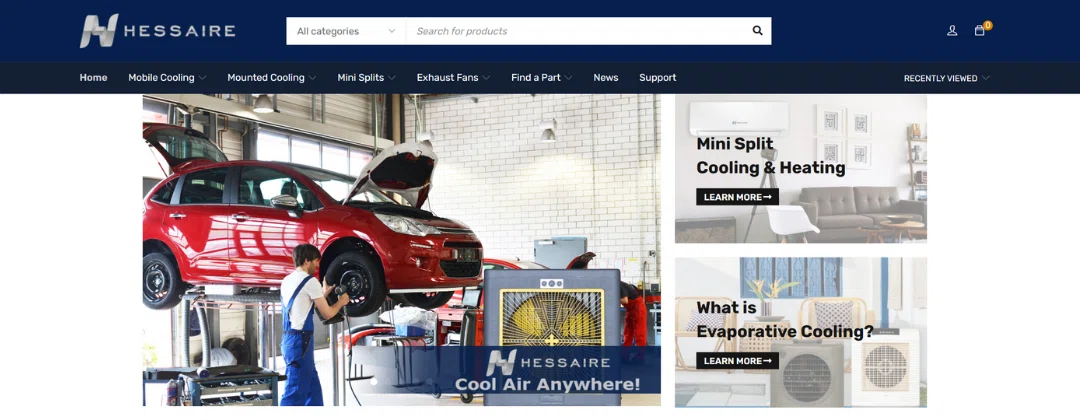
Portacool
Portacool brings to the market evaporative coolers that blend practicality with efficiency. The brand stands out for its emphasis on "One-Pass Cooling", a technology that can rapidly cool the surrounding air up to 30 degrees Fahrenheit. The coolers are designed for ease of use, with most units requiring no installation—plug in and connect to a water source. Energy efficiency is another highlight; Portacool coolers can achieve the cooling effect with roughly the energy consumption of a regular fan. Additionally, their design incorporates mobility features such as sturdy casters, making them easily transportable based on cooling needs.
The realm of greenhouse evaporative coolers is vast, with various brands offering unique solutions to meet varying cooling needs. While each brand has distinctive features and benefits, they collectively showcase the industry's commitment to innovation, efficiency, and user experience. Choosing the right brand ensures optimal cooling performance tailored to specific requirements and preferences.
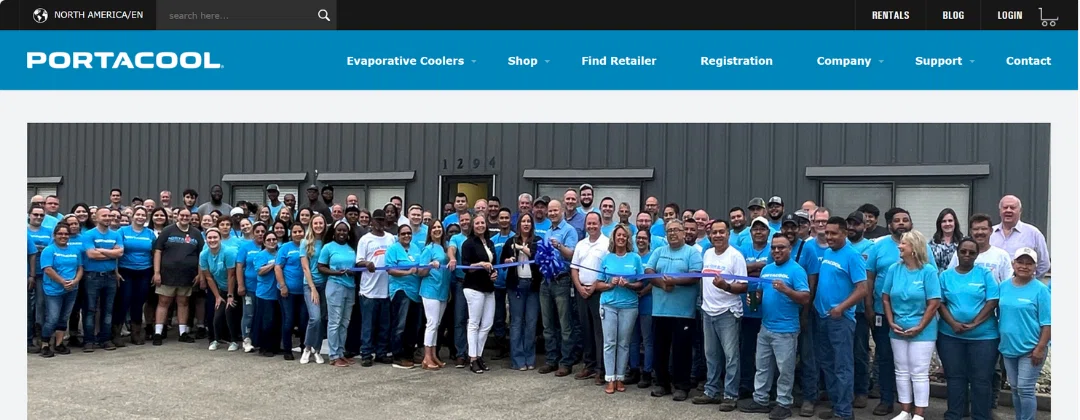
Setting and Optimizing Your Greenhouse Evaporative Cooler
A greenhouse evaporative cooler's efficiency and longevity depend on its correct setting and ongoing optimization. Getting the size right, positioning the cooler for optimal airflow, and integrating with existing climate systems are all pivotal steps in maximizing your greenhouse's potential.
Selecting Cooler Size for Cannabis Cultivation
The size of the evaporative cooler isn't just about matching the dimensions of the greenhouse. Rather, it's about understanding the cooling needs specific to cannabis and ensuring the cooler's effective coverage across the entire greenhouse space.
Understanding Cooling Requirements
Cannabis, as a delicate plant, thrives in a specific temperature range. Any deviation from this optimal bracket can jeopardize not just its growth rate but also its yield quality. This makes understanding cooling requirements paramount. Cannabis typically flourishes between temperatures of 65-80°F (18-27°C). While the plant might show resilience under diverse conditions, maintaining it within this temperature window ensures accelerated growth and premium yield quality. As the plant matures, especially during the flowering phase, it becomes more sensitive to temperature. Thus, having a cooler that can consistently regulate and maintain this range becomes indispensable. Furthermore, external climatic conditions play a role too. If the greenhouse is situated in a region with high-temperature variability, the cooler's task intensifies during peak hot periods. This factor should influence the cooler size selection to ensure it can cope with the most demanding conditions.
Considering Space Coverage
The essence of space coverage in setting up an evaporative cooler extends beyond the mere floor area of the greenhouse. It's about the volume, as the cooler is responsible for circulating and cooling air throughout this entire space. An effective cooler doesn’t just push cold air; it ensures even distribution and circulation throughout the greenhouse volume, providing uniform conditions for the cannabis plants. This becomes crucial for preventing areas of heat build-up or cold spots affecting plant health.
To determine the right cooler size based on space, one must first calculate the greenhouse's volume using the formula: Length x Width x Height. Once you have the volume, understanding the air change requirements for cannabis is the next step. Ideally, the greenhouse air should be refreshed 30-40 times per hour for cannabis cultivation. This rate ensures fresh air supply, removing excess moisture and maintaining a consistent temperature. After determining the desired air change rate, multiplying it by the greenhouse volume provides the CFM (Cubic Feet per Minute) requirement. This CFM value becomes the guiding metric in selecting the cooler size.
Choosing the right evaporative cooler size for a cannabis greenhouse is a harmonious blend of understanding the plant's specific cooling needs and ensuring the cooler's capabilities align with the greenhouse's spatial dimensions. The goal is consistent, optimal conditions throughout the cultivation period.
Placing Cooler Strategically for Cannabis Cultivation
The effective cooling of a greenhouse is not just about having a state-of-the-art evaporative cooler; it's about placing it right. And when you're cultivating cannabis, this strategic placement can make all the difference.
Maximizing Airflow
The uniform distribution of cooled air is vital to prevent pockets of heat or cold areas within the greenhouse. These pockets can create an uneven growth rate among the cannabis plants and may even lead to crop loss in extreme cases. Here are some tips to maximize airflow:
- Position the cooler at a height, preferably using an elevated stand. This promotes cold air distribution from a top-down approach, ensuring it reaches all areas of the greenhouse effectively.
- Avoid placing the cooler near obstructions such as walls, tall shelving, or other equipment. These obstructions can restrict airflow, creating uneven cooling zones.
- Consider integrating oscillating fans within the greenhouse to aid in distributing cool air. While the evaporative cooler cools the air, these fans can help push it further into hard-to-reach corners of the greenhouse.
- Regularly clean and maintain the cooler's filters and vents. Over time, dirt and debris can clog these areas, hampering the airflow.
Considering Plant Proximity
Cannabis plants have specific needs in terms of temperature and humidity for optimal growth. Positioning the greenhouse evaporative cooler near the plants can lead to over-cooling or excessive humidity, harming the plants.
- Ensure that there's a buffer zone between the plants and the cooler. This prevents the plants closest to the cooler from experiencing temperatures too low or humidity levels too high.
- Rotate plants regularly. If it's feasible, consider rotating your cannabis plants to ensure that all plants receive equal exposure to the cooler's airflow. This prevents certain plants from benefiting while others suffer.
- Observe plant reactions. Plants closest to the cooler may exhibit signs of stress, like drooping or yellowing leaves. Consider adjusting the cooler's location or settings if you notice these signs.
By maximizing airflow and carefully considering plant proximity, cultivators can achieve the ideal environment for their cannabis crops.
Integrating Climate Systems
Maintaining the desired ambiance in a greenhouse isn't simply a game of temperature control. It encompasses a broader spectrum: balancing moisture, light, carbon dioxide levels, and temperature. Each component uniquely affects plant growth, with temperature playing a pivotal role in the growth rate, flowering, and overall health.
Coordinating Heating Systems
Evaporative coolers excel at dropping temperatures by utilizing the cooling effects of evaporation. However, as they function, there can be instances when the temperature dips below the desired level, especially during nights or cooler seasons. This is where heating systems come into play.
A balanced greenhouse environment requires a fine-tuned dance between the cooler and the heater. When the cooler brings down the temperature to a level that might harm plant health, the heating system should be ready to activate, ensuring a stable and consistent environment. This harmony ensures that the plants aren't subjected to temperature shocks, which can harm their growth and yield, particularly for temperature-sensitive crops like cannabis.
Utilizing Automated Control Systems
The real power of modern cultivation lies in automation. While effective, manual monitoring can't match automated systems' consistency, especially when precision is paramount. Automated control systems continuously scan the environment, making micro-adjustments to ensure optimal conditions.
Altaqua's Grow Room HVAC System is an integrated climate control system. It provides precise temperature and humidity control and some optional functions customized to your needs. It anticipates environmental changes by utilizing advanced sensors and algorithms and adjusts the heating or cooling levels accordingly. This approach ensures that the greenhouse evaporative cooler and heating system work in unison without counteracting the other's effects.
In summary, while the greenhouse evaporative cooler is crucial, its efficiency is magnified manifold when integrated with other complementary systems. This integration ensures that the greenhouse environment remains stable irrespective of external conditions, fostering optimal plant growth.
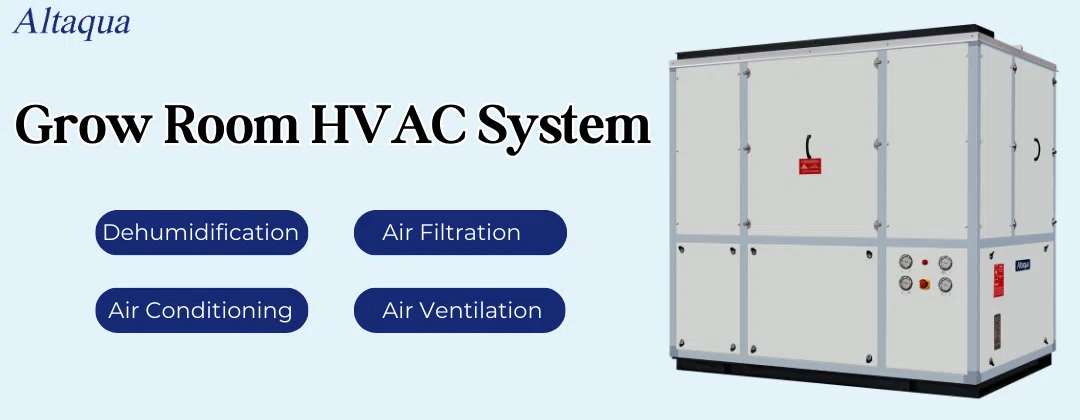
Addressing Common Challenges and Maintenance
Having established the best practices for setting up and optimizing a greenhouse evaporative cooler, it's essential to note that consistent performance requires vigilance. As we proceed, we'll delve into the challenges these systems face and the maintenance required to ensure they operate efficiently over time.
Water Quality Issues
One such challenge arises from the water we use in these coolers. Untreated water, especially from hard water sources, introduces many minerals and salts into the system. Over time, these minerals can accumulate on the cooling pads, diminishing their efficiency by reducing the surface area available for evaporation. This leads to inconsistent cooling and increases the wear and tear on the cooler's components. Regular inspection of the water source, water treatments, and occasional pad replacements can combat this issue. Moreover, consistently cleaning the cooling pads can ensure they function optimally.
Clogs and Debris
Air, in its natural state, carries particulates like pollen and dust. As the cooler draws this air, these particles can accumulate and clog the cooling pads. The repercussions of such clogs are twofold: they restrict airflow, reduce cooling, and increase strain on the system’s fan. However, the remedy is simple and effective. Regular cleaning of the pads and the internal structure of the cooler, coupled with the installation of air filters, can keep such clogs at bay.
Water Circulation Issues
Water circulation lies at the heart of an evaporative cooler's operation. Any disruption, whether due to an inefficient water pump or obstructions in the distribution system, can wreak havoc on the cooler's efficiency. Uneven water distribution results in dry patches on the pads, making cooling inconsistent and even risking system overheating. Routine checks of the water pump and distribution tubes, ensuring both are free from issues, can guarantee smooth water circulation.
Temperature and Humidity Control
Misuse or misconfiguration of the cooler can throw off the delicate balance between temperature and humidity inside the greenhouse. While an excessively humid environment can promote mold growth, endangering the plants, a less humid environment can cause undue stress. Continuous monitoring using integrated hygrometers and thermostats, paired with appropriate adjustments, can ensure the right balance is maintained.
Water Consumption Concerns
The very essence of evaporative coolers is their reliance on water. This poses challenges, especially in regions with limited water resources. To strike a balance, growers can employ moisture sensors and automated timers, which ensure water is used only when necessary. Regular inspections for leaks further conserve water, ensuring the cooler remains efficient without being wasteful.
Climate Challenges
Regions with high ambient humidity pose unique challenges for using evaporative coolers. The added moisture can potentially make the greenhouse environment counterproductive for plant growth. Understanding local climate patterns and adjusting the cooler's operation is imperative. On particularly humid days, integrating dehumidifiers can help strike the necessary balance.
Energy Costs
While greenhouse evaporative coolers are lauded for their energy efficiency, continuous operation, especially during peak hours, can still lead to significant energy consumption. Investing in energy-efficient cooler models, optimizing their operation, and considering renewable energy sources can substantially reduce costs.
Conclusively, while greenhouse evaporative coolers are vital tools in controlled cultivation, understanding their challenges is paramount. Regular upkeep and informed decision-making ensure they remain effective allies in achieving cultivation goals.
Conclusion
Evaporative cooling in greenhouses has emerged as an indispensable technique in ensuring optimal growth conditions. From understanding its fundamental principles to recognizing the diverse types of systems available, it's evident that the choice of a cooler can significantly influence the success of a greenhouse. Furthermore, while top brands continue to offer innovative solutions, it is the strategic setting, optimization, and integration with other climate systems that accentuate their efficacy.
However, it's worth noting that, while greenhouse evaporative coolers play a crucial role, they do have their drawbacks. These systems can sometimes fall short in extreme conditions, require regular maintenance, and can be influenced by external factors like water quality. Additionally, while they are cost-effective, they represent a more rudimentary approach to temperature control. With advancements in technology, many contemporary projects are leaning towards more sophisticated solutions, such as the grow room HVAC systems.
Herein lies the potential of solutions like Altaqua's grow room HVAC system. This system offers a more refined control over the greenhouse environment by harmonizing temperature and humidity levels. What's more, its remote data monitoring allows for real-time adjustments, ensuring that the environment inside the greenhouse remains optimal. This level of precision and adaptability is a testament to the evolution of greenhouse management tools. In essence, while the traditional evaporative cooler serves a purpose, growers today have options that offer more nuanced control, aligning with the modern demands of greenhouse. As the sector evolves, it's crucial for growers to weigh their options carefully, factoring in both immediate needs and future growth.
FAQ
1. What is the principle behind a greenhouse evaporative cooler?
An evaporative cooler operates on the principle of evaporation. When water evaporates, it absorbs heat from the surrounding area, leading to a decrease in temperature. In greenhouses, evaporative coolers utilize this mechanism to maintain optimal temperatures and humidity levels, ensuring an ideal environment for plant growth.
2. How do different types of evaporative coolers for greenhouses vary?
There are several types of evaporative coolers tailored for greenhouses, including the pad and fan system, misting system, wet wall system, chilled water circulation system, and exhaust fan system. Each has its unique features and advantages, tailored for specific greenhouse sizes, climates, and plant types.
3.Why is the strategic placement of a greenhouse evaporative cooler essential?
Proper placement of an evaporative cooler is vital for several reasons. Firstly, it ensures even distribution of cool air, preventing areas of excessive cold or heat. Strategic positioning also ensures maximum airflow, making the cooling process more efficient. Furthermore, considering the proximity to plants is crucial; the right distance ensures plants don't get exposed to extreme conditions which can hamper their growth.
4.What challenges might arise when using a greenhouse evaporative cooler?
Users may face issues related to water quality, clogs, water circulation, and controlling temperature and humidity. Additionally, concerns about water consumption, adapting to various climate challenges, and energy costs may arise.
5. Is optimizing the settings of a greenhouse evaporative cooler necessary?
Absolutely. Optimizing the settings not only ensures efficient cooling but also extends the cooler's lifespan, reduces energy costs, and guarantees an optimal environment for plant growth.
Share with your friends:
Popular Blogs on Altaqua:
Get HVAC Brochure?
Get HVAC Brochure?
